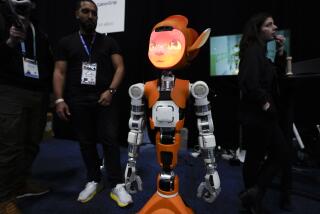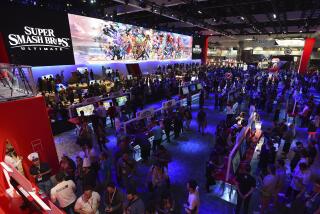Next CES a little less electrifying
- Share via
The Consumer Electronics Show in Las Vegas -- known in years past for its outsized booths, wall-to-wall crowds and lobster dinners -- is going to be a lot tamer next month.
The show’s producers are expecting an 8% drop in attendance to about 130,000 people, down from 141,000 in January 2008.
Companies such as Cisco Systems Inc., Panasonic Corp., Belkin International Inc. and Sony Corp. are sending fewer people, eliminating floor booths in favor of less expensive hotel suites or retooling their marketing message to fit the somber economic times. Hotels, normally booked solid months in advance, recently offered promotions and discounts to fill empty rooms just weeks before the show, which runs Jan. 8 to 11.
Though some attendees are looking forward to shorter taxi lines and cheaper accommodations, the shift in the tenor of the show indicates how the recession is affecting the $173-billion global consumer electronics industry, which has enjoyed uninterrupted annual sales growth for the last decade.
The Consumer Electronics Assn., the trade group that has staged CES for the last 42 years, this month revised its forecast for the industry’s U.S. sales in the fourth quarter, from 3.5% growth to just 0.1%. Though U.S. sales of devices are still expected to grow 7% overall this year, consumers have shifted how they spend their money in recent weeks, said Jason Oxman, CEA’s senior vice president of industry affairs.
“Although unit volume largely held up so far this quarter, price declines were steeper than we had anticipated, particularly over Black Friday weekend,” Oxman said. “Consumers were switching to smaller, less expensive products.”
In January, half of all flat-panel television sets sold in the U.S. were 32 inches or bigger, according to CEA. But in November, that declined to 36%. The trade group expected some products to do well this holiday, including game consoles, GPS devices, mobile phones and digital cameras. But the industry’s biggest category, which includes TVs and stereos, is expected to drop 5% this quarter.
That spells tough times for a sector that gets nearly one-fifth of its revenue from TV sales.
Consumer electronics retailers are feeling the pain. Circuit City Stores Inc. filed for Chapter 11 bankruptcy in November and said it would close 155 of its 700 stores by the end of the year. Tweeter, an electronics retailer based in Canton, Mass., liquidated its 94 stores in November. Even Best Buy, the healthiest of the retailers, posted a 5% slump in same-store sales and a 77% drop in profit during its third quarter ended Nov. 29. Last week it offered voluntary severance packages to almost all of its 4,000 corporate employees.
In response to the pressure on retailers, CEA for the first time has set aside $1 million to help defray travel and hotel costs for thousands of retail buyers, the folks who decide which products stores will sell in the coming year.
Individual manufacturers are also rushing to aid hobbled merchants. Belkin, the Compton maker of peripherals for iPods and computers, is cutting back its spending at CES and using the savings to fund joint promotions next year to drive consumers into stores.
Belkin spokeswoman Melody Chalaban said the company would send half as many employees to CES as in past years and would forgo an elaborate booth in favor of meetings in hotel suites. “We’ve exhibited at CES for as long as I remember,” she said. “It is safe to say we’ll be saving several hundred thousand dollars by doing this.”
Panasonic, one of the first exhibitors at CES and among its largest, said it would eschew entertainment such as comedic skits to focus on more pragmatic presentations aimed at helping retailers better sell their products.
“We don’t think this economic environment is a time for song, dance and entertainment,” said Bob Greenberg, Panasonic’s vice president of brand marketing.
Other companies will have similarly somber approaches at CES, said Kurt Scherf, principal analyst at Parks Associates, a technology consulting firm in Dallas.
“CES will be much more strategic for companies,” Scherf said. “Employees are being sent with very specific goals. The idea of attending just to see a bunch of cool stuff is not going to play very well in this economy.”
Cisco, for example, canceled plans for an exhibit on the show floor and instead plans to hold meetings at the Venetian hotel.
“We will have the same number of meetings and product demonstrations, but in a less public venue,” said Ken Wirth, vice president of consumer marketing for the San Jose computer networking giant. “Our activities at CES will be much more targeted.”
Somewhat counterintuitively, CEA says it has no problem with a bit of austerity. That’s partly because over-the-top displays helped kill Comdex, the big kahuna of tech conventions that imploded after its 2003 show. Companies, struggling to recover from the dot-com crash, balked at spending money on a trade show that had become too big to manage.
In that sense, CEA said it welcomes the drop in attendance, which peaked in 2006 with more than 152,000 people.
“We’re trying to manage the size of the show so that it will be easier to navigate,” said CEA’s Oxman. The group started charging a $100 registration fee for those who sign up after Nov. 1 to discourage people who don’t work in the industry.
“The value proposition we make is that you can meet the entire consumer electronics industry in one place, at one time,” Oxman said. “The average attendee last year held 12 meetings at CES.”
Such meetings will continue to form the bedrock of CES, analysts said -- even if they’re not held in elaborately appointed booths with a nonstop lineup of Vegas show-style entertainment.
“This is still the largest technology show we have in the U.S.,” said Tim Bajarin, principal analyst at Creative Strategies in Campbell, Calif. “Attendance may be down, but its impact will be just as important as ever.”
--
More to Read
Inside the business of entertainment
The Wide Shot brings you news, analysis and insights on everything from streaming wars to production — and what it all means for the future.
You may occasionally receive promotional content from the Los Angeles Times.










